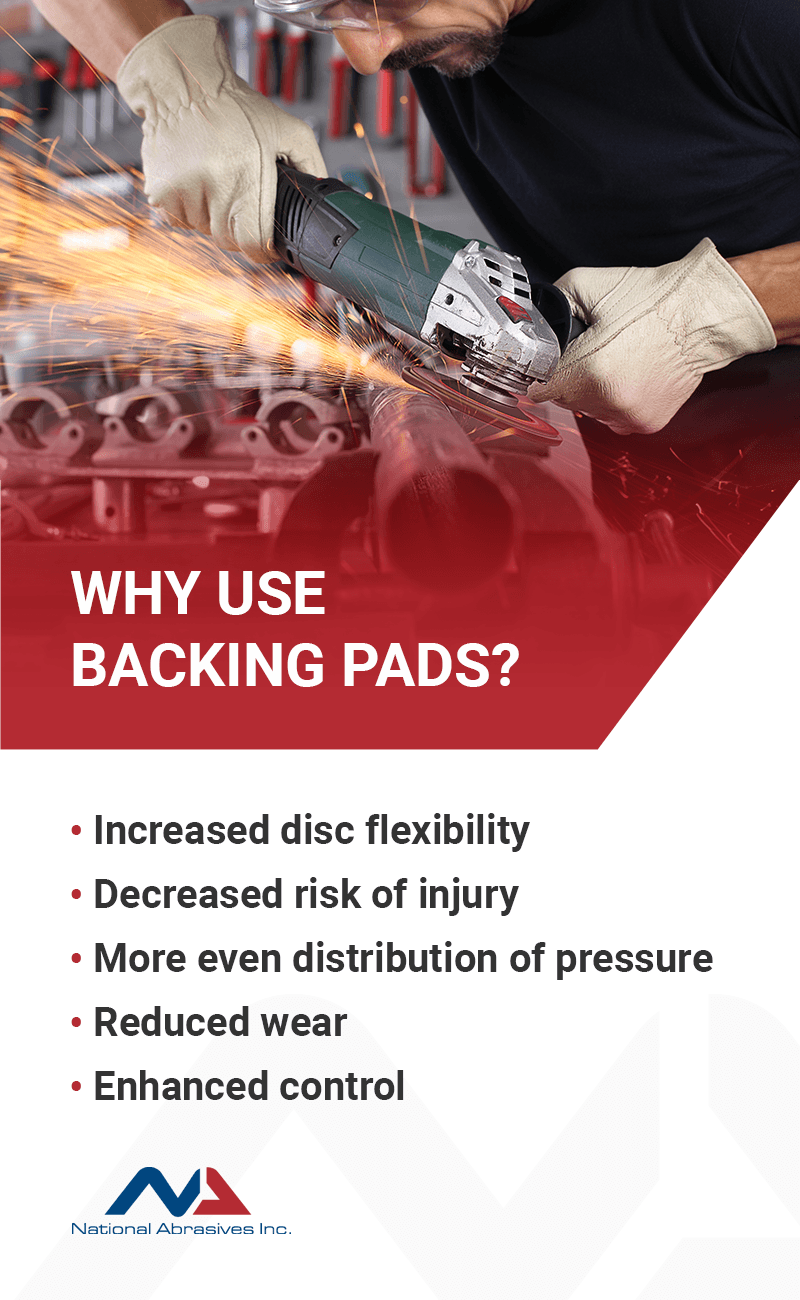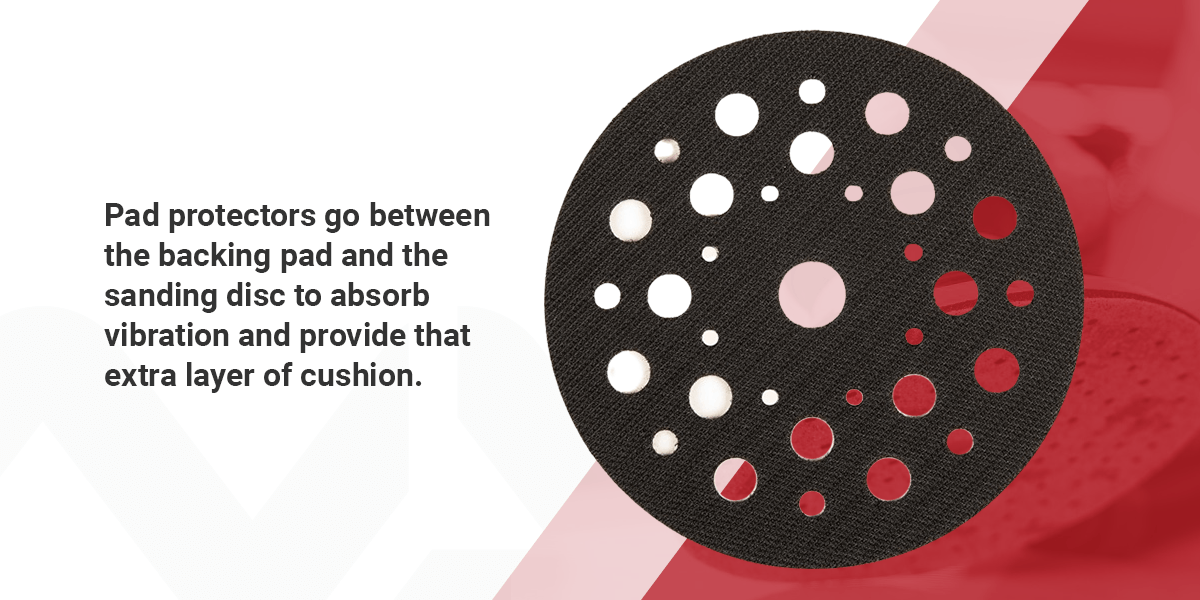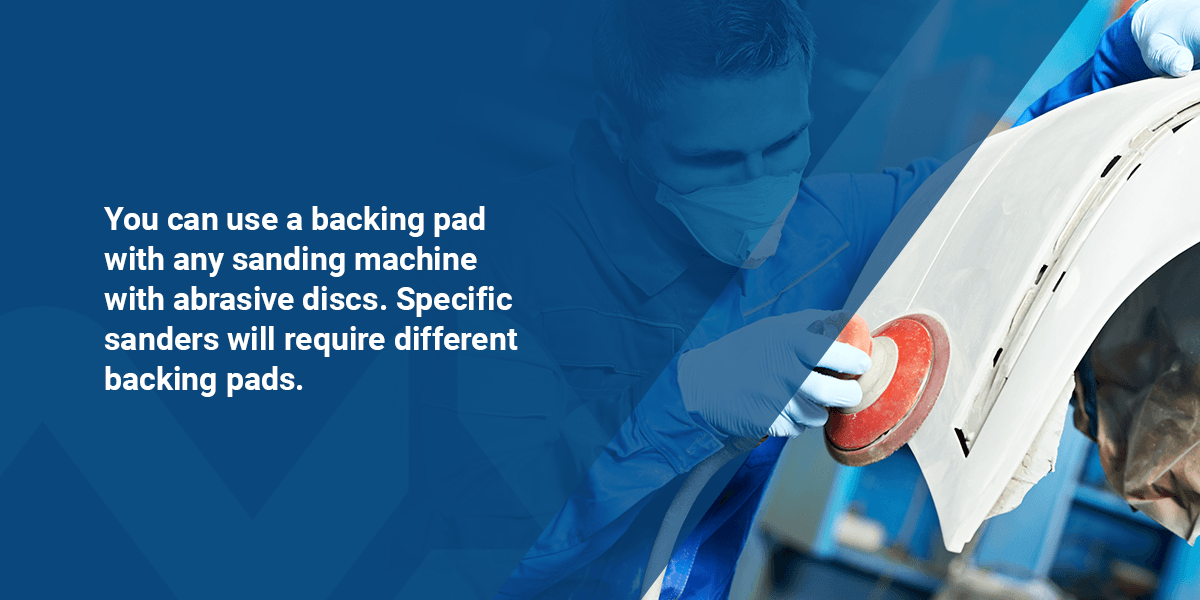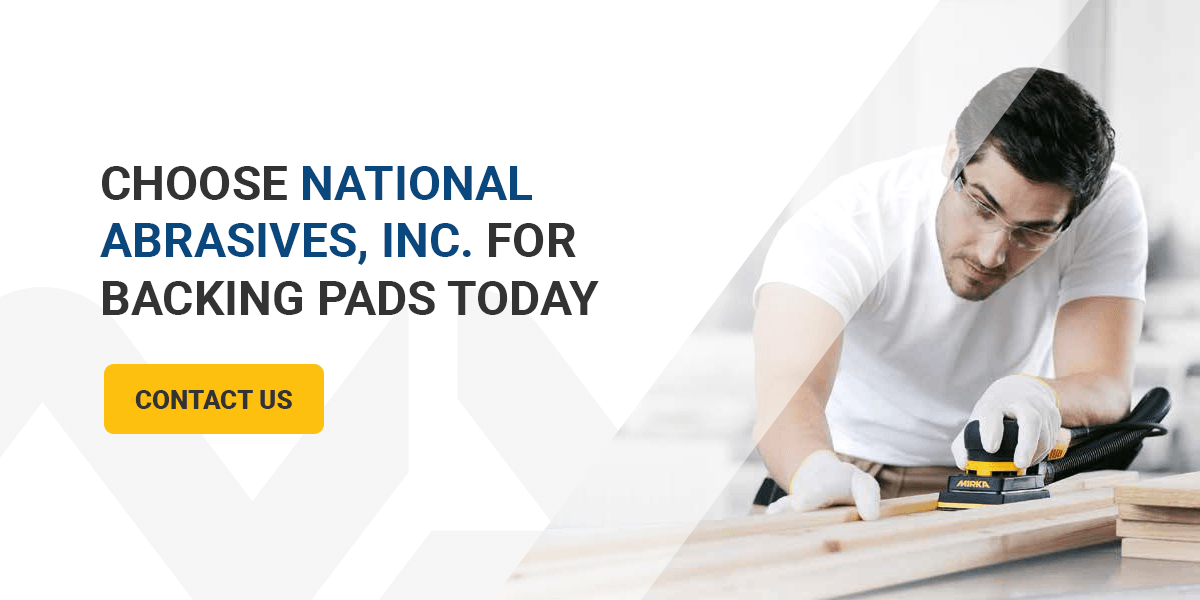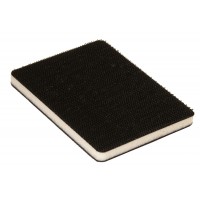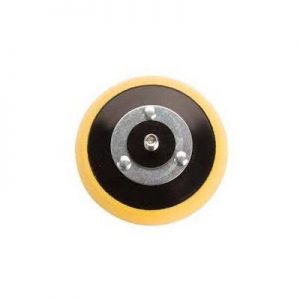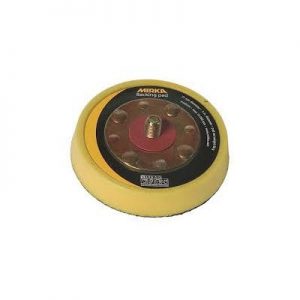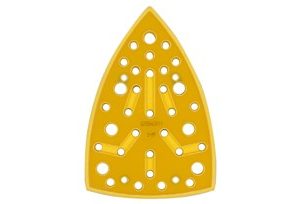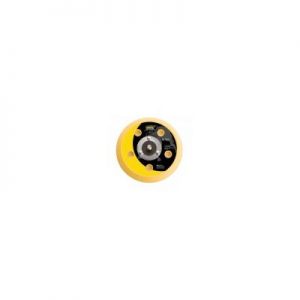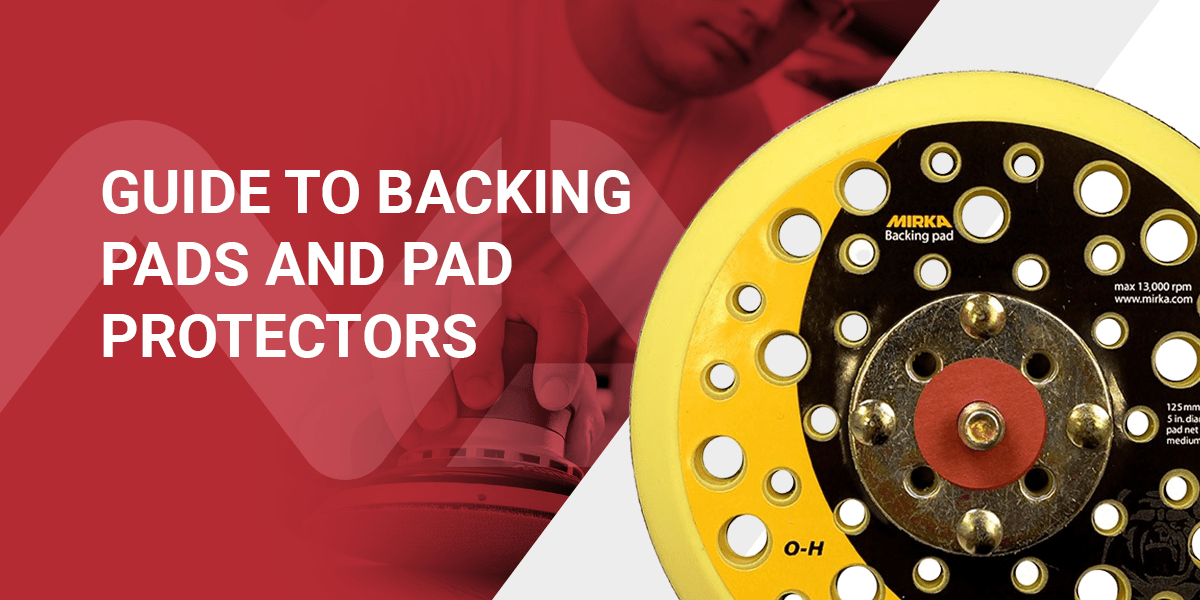
A backing pad is an attachment that secures sanding discs and other accessories on power tools. It goes beneath the sanding discs to provide adequate cushioning for the highest performance. Backing pads also help ensure the disc’s entire surface area is available for the project, which provides the most even finish.
This guide will explain the importance of and method for using backing pads and the ins and out of selecting the right backing pad for your project. Learn more below.
Why Use Backing Pads?
Backing pads are essential components for various reasons. Here are a few reasons why it can be helpful to use a backing pad for your sanding projects:
- Increased disc flexibility: Backup pads provide an extra cushioning layer that allows the disc to move more freely. This added range of motion helps the sander more easily conform to rounded edges and contours, preventing uneven sanding and jagged edges.
- Decreased risk of injury: The pad acts as a cushion to absorb strong vibrations, reducing the risk of ergonomic injuries like carpal tunnel syndrome. Plus, smoother work is generally more enjoyable.
- More even distribution of pressure: Using the disc’s maximum surface area helps ensure a uniform finish on every surface — even softer ones where nicks and gouges are more visible.
- Reduced wear: The pad decreases the wear and tear the machine sustains, which can extend the life of both your sanding discs and your sander. Additionally, backing pads enable airflow behind the sanding disc and provide a space for debris to flow out, resulting in improved contact and more effective sanding.
- Enhanced control: Sanding on an uneven surface can result in the machine jerking or moving in the wrong direction. Using a pad increases the amount of control you have over your machine, which improves the quality of your work and your overall workplace safety.
Of course, the result you get depends on the pad you choose and the application you intend to use it for.
Types of Backing Pads
There are several different types of backing pads you can choose from, characterized by attachment type, thickness and performance:
- Hook and loop pads: This type of pad is most common. It provides a secure grip for the sanding disc. Some models come with a foam layer or water feed to enable both dry and wet polishing.
- Low-profile pads: These pads generally have thicker foam than other types. They create a fine finish with medium conformability and come in several densities.
- High-performance pads: As the name implies, these pads are best for high-performance projects. They work well with resin fiber discs and quick-change discs.
- Pressure-sensitive adhesive (PSA) pads: These backing pads allow you to stick sanding discs to them with a little pressure.
- Spindle pads: These pads are suitable for PSA or hook and loop discs with smaller diameters and often include threaded shanks for attachment.
- Hand sander backup pads: These foam pads provide the comfort and softness necessary to replace finger sanders. Straps hold the pad firmly in position to allow for even sanding.
- Palm sander pads: These pads allow you to use standard hook and loop or PSA sanding discs for palm sanding applications. They come with finger indentations to increase their ergonomic comfort.
- No-spin backer pads: The free-floating disc on top of a no-spin pad minimizes potential damage to vertical surfaces.
- Zero-burn backer pads: These pads enable multi-directional movement in standard power tools. Additionally, they work to control your power tool’s temperature, which can prevent overheating.
Of course, some backer pads do not fall into any of these categories. The best solution is to experiment and find the pad that works best for your tool.
Pad Protectors
Pad protectors, sometimes called pad savers, are different from backing pads in that they’re meant to prevent excessive wear and tear on the backing pad. They also increase the sanding disc’s adhesion, as they provide a sturdy attachment point.
Pad protectors go between the backing pad and the sanding disc to absorb vibration and provide that extra layer of cushion. They’re unnecessary for most applications, but they can certainly supplement your sander’s performance. If you choose to use pad protectors, you’ll need to change them out regularly to ensure they’re always in good condition.
How to Use Backing Pads
It’s easy to use a backing pad if you know how to replace it. Each manufacturer will provide different directions for their pads, but you should generally be okay as long as you know when to replace them.
Installing a Backing Pad
The installation method will vary depending on the brand of the pad and the type of sander you’re using.
However, here are some universal tips:
- Make sure the sander is unplugged before attempting to remove the worn pad.
- Read or watch any recommended assembly instructions.
- Use all included fasteners, like screws or nuts.
- Ensure the pad is fully secure before attaching an interface pad or sanding disc. Using a wrench or other fastening tool can help here.
Backing Pad Maintenance
To ensure your power sander’s proper function, change your backing pad regularly.
In general, you should change your backing pad at least once a month. This rule of thumb may also vary based on how often you use a particular machine and the types of projects you use it for. If you don’t use the sander very often, you should be able to stretch the change interval out to every three to six months.
Here are some other signs that it’s time to switch out your backing pad:
- Change in color: Compare your old pad to a new one. If it looks faded, the foam is likely degrading, and it’s time to switch out the pad.
- Worn face material: Look at the face material on both the pad and sanding disc. If hooks are broken or wearing off, or if you find adhesive buildup on the pad, you will need to replace it.
- Worn edges: Examine your pad’s edges. If the foam looks cracked or worn, you need a new pad.
If you’re using a hook and loop pad, you can test the condition of the hooks by covering about a third of the pad with your sanding disc. If you’re still able to lift the disc, the pad is still usable.
Backup Pad Selection Guide
Knowing your sander is crucial for choosing replacement components or additional parts. This point is especially true for backing pads, which directly impact the quality of your sanding job.
The following factors are the most important to consider when selecting a backing pad.
Size, Speed and Pressure
Disc size, especially diameter, is an important factor in deciding which backing pad to use. You’ll want to match your pad to your disc — too big, and your disc won’t cover the right amount of space. Too small, and your disc might fly off.
Wider discs require more control than smaller ones. Larger discs and pads are best for applications involving wide, flat surfaces or rounded contours. Smaller pads are best for narrower contours and small surfaces.
Depending on the speed you’ll be using, you’ll need a specific disc size. We recommend the following limits for Mirka products:
- 8-inch pads: 10,000 RPM
- 5- and 6-inch pads: 12,000 RPM
- 3-inch pads: 13,000 RPM
Other brands may have different limits, so check your manufacturer’s instructions before use.
The pressure you apply is also essential, as choosing the wrong pad for the job could result in negative consequences. For example, high-pressure applications benefit from thinner backing pads because too much force can cancel out the cushioning effect altogether. Subsequently, this can cut off backing plate rotation and potentially harm your surface.
Design Features
A beneficial feature in both backing pads and pad protectors is heat-dissipating holes, which will help prevent your sander from overheating.
Additionally, the pad’s face may be patterned or solid — this will match the vacuum holes on your sanding disc.
The backing pad you choose should have features that will pair well with your abrasive disc.
Attachment Type
How your sanding disc connects to your backing pad is another critical component to consider. While the attachment type does not significantly affect your final product, it can make your project more or less enjoyable.
- Hook and loop: This attachment type is similar to Velcro in that the tiny hooks on the backing pad grab on to the small fabric loops on the sanding disc. People who prefer this type like Velcro’s secure grip and the ease of swapping out sanding discs.
- Pressure-sensitive adhesives: PSA-coated surfaces stick together when you apply pressure. These discs are easy to attach and remove, which some people find more convenient.
Sander Backing
The combination of materials you use on a sander can significantly impact your project. The backing is one essential component that interacts with your backer pad, especially concerning the pad’s flexibility.
The most common backing types include:
- Cloth: Cloth backing is generally highly flexible, although it can come in different consistencies.
- Paper: Generally, paper backing tends to be thicker than cloth, but it can vary depending on the paper’s weight. Most paper backings are not very flexible.
- Fiber: Fiber backings are the least flexible type, as they are much more rigid and denser than cloth.
You want to choose a backer pad that will interact well with your sanding disc’s backing -and the project you’re working on. For example, if your disc has a particularly thick backing and your project involves more complicated contouring, you’d do best choosing a more flexible backer pad.
Pad Thickness
The thickness of the pad you should buy will depend on the project you’re working on.
For example, if you plan to use a fine or very fine grit sandpaper, a thinner pad will be a better choice than a thicker one because it will not interfere with the sander’s function. A thicker pad will soften a fine sand and could get in the way of complex, delicate contour work.
On the other hand, a thicker pad is more advantageous for projects with prominent, rounded contouring because these pads allow for a greater range of motion.
Sander Type
You can use a backing pad with any sanding machine with abrasive discs. Specific sanders will require different backing pads. In general, it’s best to stick with the same brand as the sander, but if you’d prefer to try a new one, make sure you choose one that will fit your particular sander.
Here are a few examples:
- Rotary: Rotary sanders use a wheel-shaped disc that spins in circular patterns.
- Orbital: Orbital sanders spin square pieces of sandpaper in a circular motion.
- Random orbital (dual-action): These sanders are more versatile than other types because they have the properties of both rotary and orbital sanders.
- Detail: These sanders are iron-shaped, requiring particular sanding discs and backing pads.
Pad Texture
Whether you choose a hard or soft backing pad can dramatically impact your sanding performance.
- Hard pads: Firmer pads will provide a flatter, more rigid surface than softer ones. You’ll be able to reshape surfaces more easily, but you will have less maneuverability for contouring and irregular surfaces.
- Soft pads: Softer pads are more flexible, which will allow you to work with contours and more delicate surfaces. They also clean better than more rigid pads, but for reshaping and sturdy surfaces, you might want something a little firmer.
- Medium pads: Generally, the pad that comes with your sander will be of a “medium” consistency. It’s wise to begin with this pad for most general purposes and swap it out for another when you start more specific work.
The key for most projects will be to find a happy medium where the pad’s cushioning does not get in the way of the sander’s ability to work.
Abrasive Material
The rigidity of the abrasive you choose should interact well with your backing pad. A good rule of thumb is to consider your project when making your selection.
For example, suppose you need to maneuver the sander around extreme contours. In that case, you’ll want a flexible backing pad, especially if the abrasive you choose is typically more rigid.
Common abrasive materials for power sanders and grinders include:
- Ceramic
- Aluminum oxide
- Silicon carbide
- Garnet
- Emery
- Zirconia alumina
The backing pad you choose can significantly affect the performance of these materials, from relieving pressure to dissipating heat.
Choose National Abrasives, Inc. for Backing Pads Today
At National Abrasives, Inc., we offer a wide variety of power tools and accessories for many industries, including the automotive repair, manufacturing and educational sectors. Whether your auto body shop or university woodworking class needs sanding tools for jobs or projects, we’ve got you covered.
If you’re looking for backing pads for your power sander, consider buying from National Abrasives, Inc. As an authorized Mirka distributor, we’re proud to provide our customers with the finest sanding equipment in the industry. From power sanders to abrasive discs and backing pads, we’re your one-stop shop for everything Mirka.
Browse our online store today to find the best backing pads for your machines. Got questions? Contact us through our online form or call us at 800-459-8008 for more information.

